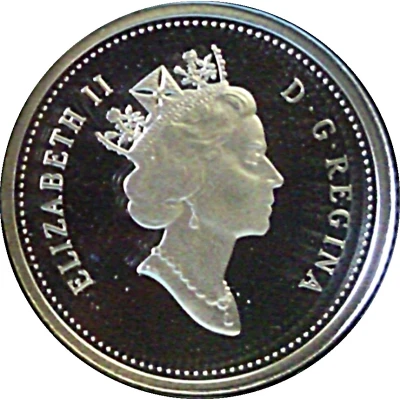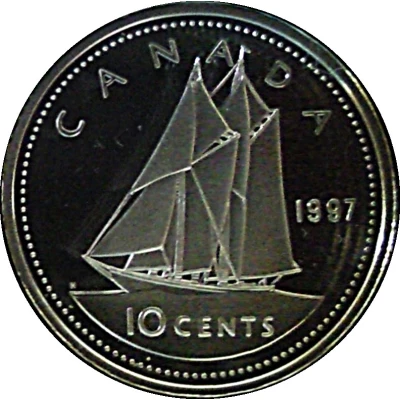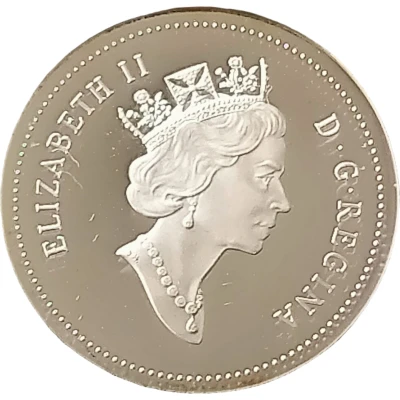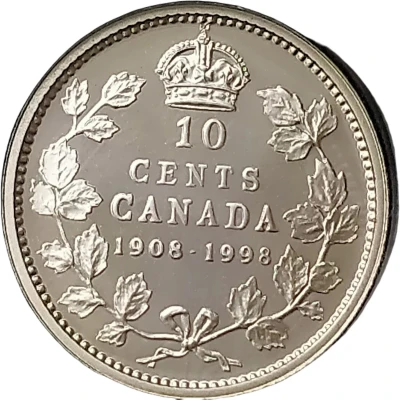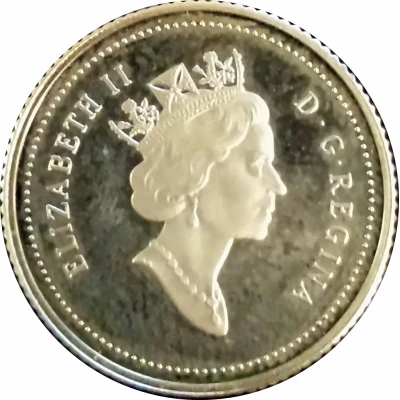
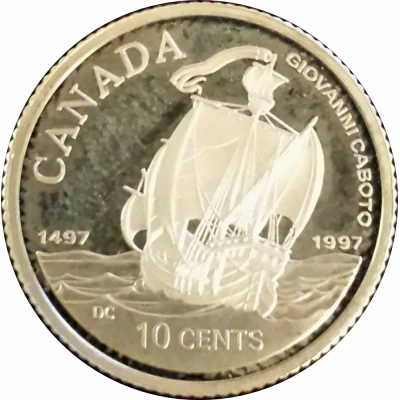

© draiv
10 Cents - Elizabeth II Caboto's Voyage
1997 year| Silver (.925) | 2.4 g | 18 mm |
| Issuer | Canada |
|---|---|
| Queen | Elizabeth II (1952-2022) |
| Type | Non-circulating coin |
| Year | 1997 |
| Value | 10 Cents 0.10 CAD = USD 0.07 |
| Currency | Dollar (1858-date) |
| Composition | Silver (.925) |
| Weight | 2.4 g |
| Diameter | 18 mm |
| Thickness | 1.2 mm |
| Shape | Round |
| Technique | Milled |
| Orientation | Medal alignment ↑↑ |
| Updated | 2024-10-04 |
| Numista | N#48772 |
|---|---|
| Rarity index | 53% |
Reverse
Caboto's Ship
Script: Latin
Lettering:
CANADA GIOVANNI CABOTO
1497 1997
10 CENTS
DC
Engraver: Stan Witten
Designer: Donald H. Curley
Edge
Reeded
Comment
Second voyage (1497)John Cabot organized a second attempt, setting sail from Bristol in May 1497 on a vessel named the Matthew. The fact that the name is the English version of John Cabot's wife's first name, Mattea, may be a happy coincidence. The names of the crew were not recorded, and all accounts of the voyage are second-hand - a remarkable lack of documentation, considering that British claims to North America would be based on this voyage.
This coin was also issued as part of a set that included a 45-cent stamp, and a 1,300 lire Italian stamp, in a multicolored Canada Post case.
The exact extent of Jean Cabot's explorations has long been a matter of debate among historians. The most reliable source on his voyage is a letter from a British merchant named Hugh Say. Written during the winter of 1497-1498, but discovered only in the mid-1950s in Spanish archives, this letter (written in Spanish) is addressed to a "great admiral" in Spain, who could be Christopher Columbus.
The approximate latitudes provided by Hugh Say suggest that John Cabot made landfall south of Labrador and on the northern tip of Newfoundland, then continued southeast along the coast to the Avalon Peninsula, from where he began his return voyage. John Cabot's crew is fearful, and it seems the men never venture further inland than the distance of a crossbow shot. They spot two figures running through the forest, possibly human or animal, and bring back a stringless "brasiline-painted" bow, which may have been decorated with red ochre by the Beothuk of Newfoundland or the Innu of Labrador. Jean Cabot also brings back a trap for a game of catch and a needle for making nets. He believes (wrongly) to see ploughed land, called in Say's letter tierras labradas, which could be the origin of the name Labrador. The merchant is also certain that the land where John Cabot landed is Brasil, a mythical island supposed to exist somewhere to the west of Ireland.
Others who have heard of John Cabot's voyages suggest that he saw two islands, a mistake possibly due to the depth of Trinity and Conception bays in Newfoundland, and that he touched down on the east coast of Asia. Some believe he reached another mythical island, the Isle of Seven Cities, which is said to have existed in the Atlantic.
It is also reported that John Cabot discovered a gigantic new fishery. In December 1497, the Milanese ambassador to England claims to have heard John Cabot declare that the ocean was "teeming with fish, which could be caught not only with nets, but also in baskets lowered with a stone". These were, of course, cod, whose abundance on the Grand Banks would later give rise to the Newfoundland fishing industry.
Interesting fact
One interesting fact about the 1997 Canadian Silver 10-Cent Coin (Caboto's Voyage) is that it commemorates the 500th anniversary of John Cabot's voyage to North America in 1497. The coin's design features a portrait of Queen Elizabeth II on one side and a representation of Cabot's ship, the Matthew, on the other. The coin was produced in a limited quantity of 25,000 and is considered a collector's item.
Price
| Date | Mintage | VG | F | VF | XF | AU | UNC |
|---|---|---|---|---|---|---|---|
| 1997 | 49848 | - | - | - | - | - | - |
Values in the table are based on evaluations by sales realized on Internet platforms. They serve as an indication only for 10 Cents - Elizabeth II (Caboto's Voyage) 1997 coin.
